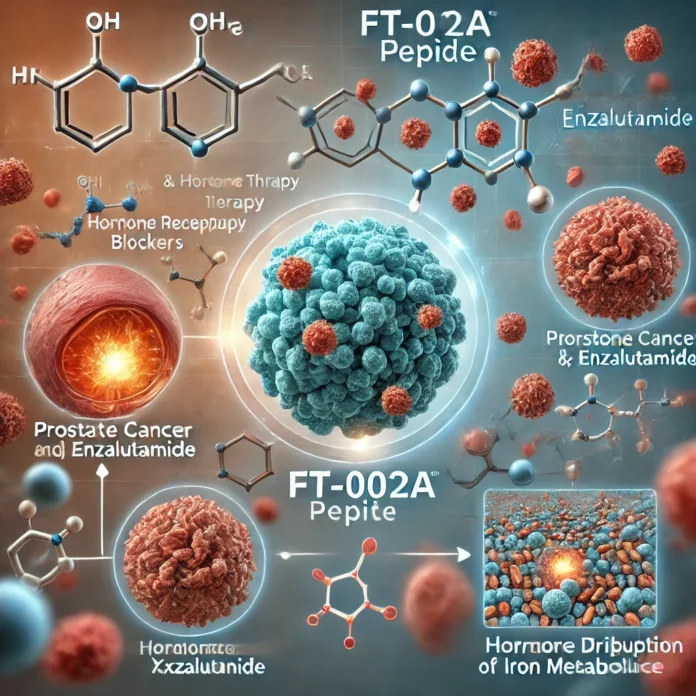
New Hope for Prostate Cancer: HBC Immunology’s Breakthrough Therapy Enhances Treatment
Prostate cancer is one of the most common cancers affecting men globally. In the UK alone, approximately 55,100 new cases are diagnosed every year. While hormone therapy remains a widely-used treatment, many patients face challenges when tumours develop resistance to current therapies. However, a new development by HBC Immunology (HBCI) offers renewed hope in the fight against this disease.
HBCI recently announced promising results from preclinical studies of its lead peptide, FT-002a. This oral formulation has shown the ability to significantly enhance the effectiveness of the androgen receptor inhibitor Xtandi (enzalutamide) — a drug already in use for prostate cancer treatment. With these positive results, HBCI is gearing up for further clinical trials that could reshape the future of prostate cancer therapy.
The Growing Challenge of Prostate Cancer
Prostate cancer is a major health issue, particularly for men over the age of 50. Hormone therapy, which blocks or reduces testosterone, plays a vital role in the treatment of prostate cancer. Testosterone can stimulate the growth of prostate cancer cells, so lowering its levels can help slow down or stop tumour growth.
However, over time, cancer cells can become resistant to hormone therapy, finding ways to bypass the treatment and continue to grow. This resistance often leads to disease progression, limiting the effectiveness of available treatments.
According to the latest research from HBCI, there may now be a solution to this challenge. FT-002a has demonstrated its ability to work alongside existing cancer treatments to overcome this resistance, potentially offering a much-needed lifeline for prostate cancer patients.
HBCI’s Breakthrough: FT-002a Enhances Treatment Effectiveness
HBC Immunology’s research centers on using peptides to combat cancer by targeting specific biological pathways. In its latest studies, the company’s lead peptide, FT-002a, was tested in combination with the widely-used androgen receptor inhibitor Xtandi (enzalutamide). The results were highly promising, with FT-002a significantly boosting the anti-tumour activity of Xtandi in prostate cancer models.
Xtandi is commonly prescribed for men with advanced prostate cancer that no longer responds to hormone therapy. The drug works by blocking the androgen receptors that cancer cells use to grow. While Xtandi is effective, cancer cells often find ways to develop resistance, reducing the drug’s impact over time.
HBCI’s peptide aims to reverse this resistance by targeting the iron metabolism pathways in cancer cells. Prostate cancer cells, like many other cancer types, have a higher demand for iron compared to normal cells. This reliance on iron plays a key role in tumour growth and spread. FT-002a disrupts these processes, enhancing the cancer cells’ sensitivity to treatment.
The company’s xenograft studies (which involve transplanting human cancer cells into animal models) showed that the combination of FT-002a and Xtandi not only increased tumour regression but also significantly reduced the biomarkers of free iron within the cancer cells. This suggests that FT-002a’s mechanism of action is functioning as intended, offering a potentially powerful tool in the fight against prostate cancer.
The Importance of Targeting Iron Metabolism
One of the most exciting aspects of HBCI’s research is the discovery of how cancer cells exploit iron metabolism pathways. Unlike normal cells, cancer cells require more iron to fuel their rapid growth. This increased iron demand helps tumours thrive, but it also provides a potential vulnerability that treatments like FT-002a can exploit.
Bomi Framroze, CEO of HBCI, highlighted the significance of this breakthrough:
“The ability of cancer to hack the iron metabolism pathways is an important driver of tumour growth and spread, and a means by which cancers can overcome the effects of treatment.”
By targeting iron metabolism, FT-002a offers a new approach that could be applied to prostate cancer and potentially other cancers as well. The peptide’s ability to enhance existing therapies and reduce treatment resistance makes it a particularly promising candidate for further development.
Next Steps: Investigational New Drug Application
Building on the success of these preclinical studies, HBCI is now preparing to submit an Investigational New Drug (IND) application for FT-002a in the fourth quarter of 2025. This submission will allow the company to begin human clinical trials, a critical step towards making the treatment available to patients.
The development of FT-002a could mark a significant advancement in prostate cancer treatment, offering new hope to patients who have exhausted current treatment options. As hormone therapies like Xtandi become less effective over time, the ability to combine them with peptides like FT-002a could drastically improve patient outcomes.
Looking Ahead: The Future of Prostate Cancer Treatment
Prostate cancer remains a complex disease with many challenges, particularly when it comes to treatment resistance. However, breakthroughs like those demonstrated by HBCI’s FT-002a offer a glimmer of hope for both patients and healthcare providers.
With the potential to enhance the effectiveness of existing treatments, reduce tumour resistance, and improve overall patient outcomes, FT-002a could be a game-changer in prostate cancer therapy. As the world awaits the results of future clinical trials, this breakthrough reminds us that innovation in cancer research continues to push the boundaries of what is possible.
Conclusion
The battle against prostate cancer is ongoing, but HBC Immunology’s latest discovery could represent a turning point in treatment. With 55,100 new cases of prostate cancer diagnosed in the UK every year, advancements like FT-002a are critical for improving survival rates and quality of life for patients. As HBCI prepares to move forward with its investigational new drug application, the medical community remains hopeful that this promising peptide will help overcome the challenges of treatment resistance and offer new options for those in need.


